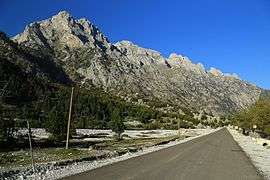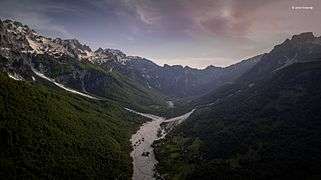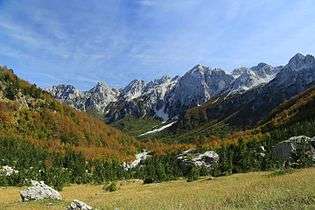Valbonë Valley National Park
| Valbona Valley National Park | |
|---|---|
|
IUCN category II (national park) | |
|
The park during the autumn season. | |
 | |
| Location |
Tropojë |
| Nearest city | Bajram Curri |
| Coordinates | 42°27′12.6000″N 19°53′28.6800″E / 42.453500000°N 19.891300000°ECoordinates: 42°27′12.6000″N 19°53′28.6800″E / 42.453500000°N 19.891300000°E |
| Area | 19,768.35 acres (7,999.97 ha)[1] |
| Established | 15 January 1996 |
| Governing body | ADZM Kukes |
The Valbonë Valley National Park (Albanian: Parku Kombëtar "Lugina e Valbonës"), also known as the Albanian Miracle of the Alps, is a National Park in Albania and part of the Prokletije mountain range.[2] The park was designated in 1996. It covers almost 8,000 hectares including the Valbonë Valley and the Valbonë River and lies between high and craggy peaks bordering on Theth National Park, Gashi River, Plav and Gusinje, which are all strictly protected natural areas.[3]
It is a transboundary park in Albania and Montenegro, with the highest biodiversity value of the country's mountain mainland.[2] This park is also referred to as the Gem of Albania. Kosovo, Albania, and Montenegro are planning to create another tri-state park in the area, that will be called the Balkan Peace Park.[4]
Four villages are located within the park (Dragobi, Valbonë, Cerem and Rragam) with 852 inhabitants. All of these factors create more favorable conditions for coexistence and socioeconomical development, including Valbona National Park. Clean air, high and characteristic mountain peaks, lakes, numerous water resources, forests, mountains, flora and fauna provide conditions for profitable eco tourism.[2]
Overview
The park was established in Albania on 15 January 1996 by the Decision of Council of Ministers number 102. The area of the national park encompasses 8,000 hectares. Its administration operates within the organizational framework of the 'Directorate of Forestry Service of Tropojë' district. However, it is located in the highest part of the Albanian Alps bordered on Montenegro. The park protects the upper section of the Valbonë Valley and Valbonë River, noted for its morphology, landscape, forests, and for the plant and animal species. Valbona Valley has a length of 27 km. It starts at the Shtrejti Canyon, 220 metres above sea level and ends at Valbona Pass at 1800 metres above sea level.[5] Spreading in the south from the highest peak of the whole Bjeshkët e Namuna mountains range, Maja Jezercë (2 694 metres), this valley was formed by glaciers and tectonic detachments.[6] Valbona is the name of the river which flows out through Valbonë Valley and the village bearing the same name.[7]
Environment
Topography
The National Park is located in the Albanian Alps. It Lies in the geographical widths 42° 22′ 20″ – 42° 31′ 00″ and geographical lengths 19° 47′ 50″ – 20° 06′ 00″. The slopes have slope from 10 to 450 metres, with general position northeast altitude and 300 to 2625 metres above sea level. Alps continue beyond the state border, north to High Carty in Montenegro, near Plavë and Gucia and to the east with Sharr Mountains in Kosovo. The climate is Mediterranean climate.[8]
Relief
It has an arc flow from the Yellow Hole (2344 m), and this arc continuous from the summit of the "Fever Mountain" (2356 m), tops of "Rogami's Mountain" ( 2478 m ), tops of Mount Jezerca ( 2642 m), tops of "Lapuka's Mountains" (2575 m), tops of "Valbona's Mountain" (1966 m), tops of Bolsh 's Mountain " (2414 m) , tops of Zhapora's Mountains (2516 m) tops of "Band of the Bear Mountain " (2468 m).[9] The mountain slpoes are almost vertical, with perpendicular rocks hanging on the river, peaks in the shape of towers dressed by trees, with their cirques filled with eternal snow altitude differences with the river bed that reach 1.700 m.[10]
Geological formations are composed of limestone rocks, limestone - siliceous, clay shale and conglomerate.[11] Gray forest soils are located on limestone rocks.[8] Agricultural lands are brown forest soils and soils meadow mountain.[12] There are grey forest soils between 500 and 1200 meters heights, then come Velvet Lands extending the left slope of this valley from Mbaskollata to Shoshan at height 400–900 meters. Their geological construction (alps) is diverse, with the oldest formations, those paleozoic ones, with which are related quartz mineral properties in river valley. Limestones that come from mesozoic,are wider spread, and serve as the basis of bauxite. They form the alps main ribs. Mixed with dolomite and modeled by karsts they form to Alpines a very bitter relief. Insoluble flysch deposits have formed a very harsh terrain.[13]
Hydrography
The ater resources are represented by the Valbona River and its branches, which pass through some small valleys, the Xhema's Lake, the Shoshani Source and many waterfalls.
The Valbona River has its springs at the slopes of Mount Jezercë, and goes down along the craggy riverside for almost 50.6 km. It disappears at the Rragami gritty earth and then begins again at Valbona village. It flows away through the village and continues flowing towards Dragobia.[14] Valbona River is a tributary of Drini River, which drains into Adriatic sea.[15] Deduction from the peaks of the mountains of Rragami and Ceremi, is impulsive, full sound of effervescence for its terrain topography. At Shoshan's canyon, Valbona's river narrows sharply and creates the image of the rocks being cut as with a knife.[11] Water is clean, bright and highly transparent up to 1 m depth. Frequent rain precipitations make this river unnavigable.[11]
The Xhemas Lake is a natural basis, which is supplied by the water that steams inside this base from the depth of rocks and reaches up to 3 m depth in winter. It has an area about 500m2. Lake has an altitude of 770 m above sea level. There is the main road close to it that goes from Dragobia to Valbona, exactly in "Quku i Dunishes", in the left of pedestrian road which arrives in the forest. Xhema lake has very cold clear water, rugged limestone cliffs and is surrounded by beech trees.[16]
Shortly after the source of Valbona's river, colliding with rocks, is created a 50 metres high waterfall, which disappears at Rrogami gritty earth for about 5 km and then stems again at Valbona village.[17]
The Shoshani Source is one of the biggest water sources of the Balkan peninsula. It is located at the entry of Valbonë Valley and is continually visited by alpine nature lovers. The source provides potable water for the entire Tropoja District and its water quantity is equal to the half one of Valbona river.[18]
Climate
The valley has a mountain climate with harsh winters and numerous precipitations of rain and snow. It gets exacerbated when approaching the depth of the Alps. Valley it is the coldest area of the country. Annual air temperature average varies from 7–10 °C and in places with altitude 4–6 °C. The coldest periods are from December to February. In some cases the temperatures go down to −10 °C to −20 °C. The number of snowy days, gets bigger, mainly during December-march. Snow begins in late October and stays until the end of March. Snow reaches a height of 1.5–5 m and lasts 60–160 days. Summer is considered to be quite cool. The hottest months are July and August, the temperature goes up to 22 °C. The average altitude of annual precipitation ranges 2000–2500 mm / year and in particular areas over 3000 mm / year.[11]
The environment of this area is quite diversified. Major differences between forms of relief, limestone composition of rocks, water, numerous springs and numerous types of microclimates enable biodiversity in the valley.[17]
Biodiversity
Valbonë Valley is considered to be the only area in Albania, where a big number of forest formations with spruce (Picea abies) can be found, important species of Central Europe which is found at 850–1200 masl.[11][19] Climate is suitable for beech (Fagus sylvatica), mountain pine (Pinus leucordemis), balcan pine (Pinus peuce), mountain pine (Pinus silvestris), chestnut (Castanea sativa), nuts (Junglans regia), wild apple (Malus sylvestris), etc.[17] It is an area where nature takes its place in the absence of human intervention, so it is generally virgin part of our planet.[2]
This park represents one of the most important national bio centers of wild fauna. It is a habitat for large mammals, such as bear (Ursus arctos), wolf (Canis lupus), lynx (Felis lynx), deer (Capreolus capreolus), wild goat (Rupicapra rupicapra), wild boar (Sus scrofa).[2][17][19] We can also witness the presence of western capercaillie (Tetrao urogallus) and eagle (Aquila chrysaetos).[19] Sources of water, becks and glacial lakes are the basis of life for water insects, amphibians, and salmons (trout with red dots). Within the park territory we can found vulture, stripped tailed eagle, woodpecker and a significant number of seasonal singer birds.[2]
Demography
Valbonë Valley has been inhabited since classical times what argues for the proper conditions that valley provides. The villages where the population is concentrated are: Rrogam, Valbona, Dragobi and Çerem which are located at the valley extensions.After 90’ the situation began to change. As a result of not favorable economic conditions, the majority of the population moved out. Valley is inhabited by "Krasniqi" and "Gashi" tribes.[20][21] A part of the population that has left the village, is settled at lower villages of Margegajmunicipality. Despite the recent changes that have been made in the demographic structure, the population still differs for its vitality. This affects at their ability to be active in the sector of tourism. Only during the years 1995-2002, villages like Çerem and Rragam have had a population decrease respectively of 63% and 57%.In 2008 the population at these villages was 920 persons but now it’s 817. Stopping the phenomenon of the people leaving their country, is important, in order to reduce the risk of villages turning into seasonal ones.[22]
| Village | Demography | Male | Female | % of females | Number of families | Family members average |
|---|---|---|---|---|---|---|
| Dragobi | 370 | 192 | 179 | 48% | 112 | 3.3 |
| Çerem | 208 | 110 | 98 | 47% | 67 | 3.1 |
| Valbone | 299 | 127 | 112 | 47% | 69 | 3.46 |
| Rragami | 103 | 46 | 57 | 55% | 22 | 4.68 |
| Total | 817 | 474 | 446 | 49.25% | 270 | 3.63 |
Traditions
In family and social life there are preserved folk festivals with various forms of entertainment. Spiritual wealth is manifested in verbal and musical folklore, especially in the legendary epic.
Among the traditional festivals of the area are Saint George (Shën Gjergji), which is celebrated at 6 May as "The summer’s day", "Saint Nikol" (Shënkolli) a religious holiday celebrated at 5 December and 26 December or Dukagjini’s.[2] Popular folk dances of the area are 'Men's Dance', 'Dance of the Bride', 'The Sword Dance' and 'Dance of Flowers'.[2][17] Legendary songs associated with two-stringed lute, flute, zumara, leaf sheet with the toy are also among the values which need to be treasured.[2]
Economy

The Valbona Valley offers natural and cultural potential for the economic development of the area. The peripheral position, wars, hostile climate, deficient and not functional infrastructure are factors affecting the economic backwardness of Valbona Valley.[22] The population of the are living mainly from the agriculture and farming.[23]
Being a protected area, it makes forestry impossible to be developed. The industry is represented by a Water bottling factory called Valbona. Tourism which recently is being developed rapidly, is considered to be the future’s sector of Valbona Valley. However the population still can’t provide their living only by tourism.[22]
Agriculture
Agriculture is ranked on the top in the economical structure of the area since it provides income for majority of the local people. Agricultural land is generally scarce and located on the slopes and some small valleys. Land users care for both, the preservation and cultivation. The land is divided into portions, according to family property. A particular thing of the area is that the possibilities of irrigation of agricultural land are numerous and unlimited. Agricultural land is mainly used to cultivate corn, potato, rye, beans, vegetables and fodder. Agricultural and livestock products are completely natural (organic).[2] Food is generally fresh and home made, but sometimes it can be even canned and processed by the inhabitants of the village.[7] Their way of cooking is entirely traditional. Besides agriculture, inhabitants deal with breeding of livestock such as cattle, sheep, goats, horses, poultry, beekeeping etc. Locals produce products such as meat, milk, wool and skins.[2]
Tourism

Considering the benefits that tourism can provide, the national government has classified it as a priority.[22] Even though it is based mainly on nature, the tourism in Valbona requires the necessary infrastructure. The rocky peaks of mountains such as the Mount Jezercë, Kollata e Keqe Mount, Pecmarra Mount attract the attention of visitors.[2] The Valbona River is unnavigable because of the frequent rains. The nature is rich in suitable varieties for tourism such as fishing and mountaineering. The numerous potentials of the valley enable the developing of several types of tourism such as climbing, white, rowing, rural, cultural, gastronomic, medical and adventurous tourism.
- Alpinism is based at the presence of high mountains. Foreign tourists practise mostly this kind of tourism in Valbona.
- White tourism, is seen just like a potential, as the infrastructure needed for this kind of tourism is not suitable, despite the presence of snow for about 6 months.
- Rural, cultural and gastronomic tourism is based in the locals lifestyle, legacy and traditions which has been treasured by them.
- Medical tourism is based on the healthy climate, clean air and water and the organic foods that valley offers.
- Adventure tourism has suitable conditions to be developed due to the wild nature.
Local people are building up their income with tourism activities such as renting rooms, accompanied by characteristic local hospitality and traditional home made cooking. Initiated and supported by the Government of Albania, the Albanian Development Fund and Margegaj Municipality is being built a tourism complex which should accommodate around 500 people, on a surface of 4200 m2. Valbona National Park is expected to be one of the most important oases of the country.[2] Clean air, high mountain peaks, lakes, numerous water resources, forests, mountains, flora and fauna of Valbona Valley National Park provide conditions for eco-tourism experiences.[2][11]
Monuments
Natural monuments incluce the:
- Cave of Dragobia
- Valbona Sources
- Valbona Picea's
- Glacial Valleys of Kukaj
Gallery
 Albanian horses in the park
Albanian horses in the park.jpg)
.jpg) The endemic Tulipa albanica on the park
The endemic Tulipa albanica on the park The valley formed by the Shalë river
The valley formed by the Shalë river During the twillight
During the twillight Xhemas Lake
Xhemas Lake
See also
- Environment of Albania
- Biodiversity of Albania
- National Parks of Albania* Valbonë
- Valbonë Valley
- Lake Koman Ferry
- Tourism in Albania
References
- ↑ "Listing of acreage as of December 31, 2011". Land Resource Division, National Park Service. Retrieved 2012-03-07.
- 1 2 3 4 5 6 7 8 9 10 11 12 13 14 ["Parku kombëtar i Valbones dhe prespektiva e zhvillimit te turizmit", WWF (World Wildlife Fund), Admir Seci, Abdulla Diku]
- ↑ Albanian National Agency of Tourism. "Valbona Valley National Park" (in Albanian). Retrieved 28 July 2010.
- ↑ Sulejmani, Edlira. "Bashkepunimi rajonal bisedime per nje park kombetar shqiptaro-kosovaro-malazez". Alsattv (in Albanian). Retrieved 28 July 2010.
- ↑ ["Udhërrëfyesi i Valbonës", published by Deutsche Gesellschaft für Internazionale Zusammenarbeit (GIZ) GmbH, page 1.]
- ↑ [Feasibility Study: PROKLETIJE / BJESHKËT E NEMUNA MOUNTAINS]
- 1 2 "Valbona Valley National Park" (in Albanian). Valbona Valley. p. 1.
- 1 2 ["Pyjet e virgjër të Shqipërisë" group of authors, 1997, chapter IX, p. 254.]
- ↑ [Instituti Gjeografik i Shqipërisë, Gjeografia Ushtarake", author: Prof. Dr. Myslim Pasha, Tiranë 2006, fourth part, IV.I. Lugina e Valbonës.
- ↑ ["The guide of Valbona", published by Deutsche Gesellschaft für Internazionale Zusammenarbeit (GIZ) GmbH, p. 2.]
- 1 2 3 4 5 6 ["Zonat e mbrojtura natyrore, parqet kombëtare të Shqipërisë", group of authors, 2004; pages 81-84.]
- ↑ [Zhvillimi i turizmit dhe mjedisit në qarkun e Kukësit (Studim vlerësimi), group of authors, 2010]
- ↑ [Burimet Natyrore te Shqiperise se Veriut- Tirane, authors: Kola H., Meta M. Mars 2005, p. 15]
- ↑ ["Vendlindja Ime Tropoja", authors: Lulzim Logu, Gjon Neçaj, p. 18.]
- ↑ http://www.summitpost.org/bogi-263-evica-bogi-231-evica/354583
- ↑ "Valbona Valley". Adventure and fun Albania.
- 1 2 3 4 5 "Guidë trustike (udhë-rrëfyese)Lugina e Valbonës", authors: Beqir Bala, Briken Osmani, p. 6-13]
- ↑ ["Vendlindja Ime Tropoja", authors: Lulzim Logu, Gjon Neçaj, p. 20.]
- 1 2 3 ["Zonat e mbrojtura të Shqipërisë",authors Nihat Dragoti, Zamir Dedej dhe Pëllumb Abeshi, 2007;chapter 6, page 204.]
- ↑ "Shqipëria e Epër" author Theodor Ipen, Viena 1908, chapter "Lugina e Valbonës"
- ↑ ["Nuk e harrova Malësinë e Gjakovës" author Mustafë Elezi, published by EMAL, Tirana 2010.]
- 1 2 3 4 ["Studime Albanologjike IV, Gjeografi", group of authors, pp. 457–60.]
- ↑ [Komuna Margegaj "Strategjia afatmesme e zhvillimit 2009-2015"]
External links
| Wikimedia Commons has media related to Valbona. |
- Visit Albania
- Journey to Valbona
- Kukes County Protected Areas Administration Official FB Page
- Thethi Guide


